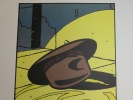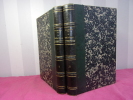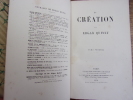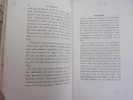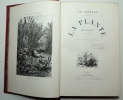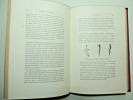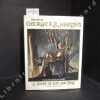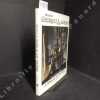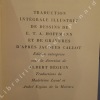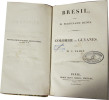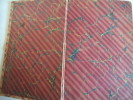-
Type
Book (662)
Magazine (12)
Maps (1)
-
Latest
Last 24h (3)
Last month (11)
-
Language
Dutch (1)
French (674)
-
Century
16th (1)
17th (1)
18th (15)
19th (26)
20th (262)
21st (51)
-
Countries
Belgium (117)
Brazil (1)
Canada (1)
Denmark (7)
France (541)
Greece (1)
Switzerland (7)
-
Syndicate
ALAC (1)
ILAB (135)
NVVA (1)
SLACES (1)
SLAM (124)
" La plus belle histoire du monde "
France-Loisirs, 1997. In-8 relie sous jaquette, 178 pages.Excellent etat.
" Le secret de nos origines "
la perse.
Firmin-didot Frères Paris 1841 Fort in-8 broché.Couverture orange et bleue, titre et décors en blanc.L'Univers pittoresque. Histoire et description de tous les peuples, de leurs religions, moeurs, coutumes, industrie &.Asie tome 2.La Perse.491 pages.2 cartes.86 planches hors-texte.Rousseurs éparses, dos recollé avec manques.
Japon, Indo-Chine, Ceylan.L'Univers Pittoresque.
Firmin-Didot Frères Paris 1850 In-8 broché.Couverture jaune et bleue, titre et décors en blanc.L'Univers pittoresque. Histoire et description de tous les peuples, de leurs religions, moeurs, coutumes, industrie &.Asie Tome 8.Japon, Indo-Chine, Empire Birman ( ou Ava ), Siam, Annan ( ou Cochinchine ), Péninsule Malaise, etc. Ceylan.665 pages.3 cartes.20 planches hors-texte.Rousseurs éparses. Dos absent.
Homme (L') devant l’univers.
Paris, Flammarion (Bibliothèque de Philosophie scientifique), 1949 ; in-8, broché ; 292 pp., (1) f. de table ; couverture rose imprimée, illustrée en blanc.
Edition originale. Exemplaire en bon état.


Phone number : 06 60 22 21 35
La création de l’homme et les premiers âges de l’humanité.
In 4 demi toile verte d’éditeur,titre,caissons dorés (oxydés)Faux-titre,frontispice en couleurs,titre avec vignette,840 pages,350 gravures sur bois,5 planches tirées à part,2 cartes de dolmens (dont le frontispice)C.Marpon et Flammarion 1887 Bibliothèque scientifique et populaire publiée sous la direction de Camille Flammarion,rousseurs habituelles,coiffe supérieure fragiles
"Lumière derrière les barreaux; lettres et témoignages (1944-1955), recueillis par le Père Louis Mouren, aumônier des prisons."
Paris, Fayard, 1988. 15 x 24, 276 pp., 4 illustrations en N/B, broché, bon état (1 cachet du Collège jésuite Saint Stanislas à Mons).
Recueil précédé d'un portrait du Père Mouren.
Guide-SAF de l'astronome amateur.
Paris Société astronomique de France 1986 Un volume in-8 broché, couverture noire illustrée, 179 pages, illustrations en n&b. Bon état.
La librairie est ouverte du mardi au samedi de 9h30 à 12h30 et de 13h30 à 19h00. Commandes par courriel ou téléphone. Envoi rapide, emballage soigné.
Les Celtes.
Gallimard Univers des formes Gallimard, Coll. L'Univers des Formes, 1979, 324 p., cartonnage éditeur sous jaquette, sous son étui (frotté), environ 28x22cm, bords de la jaquette un peu frottés, une pliure sur la page de garde, quelques rousseurs sur la dernière garde, bon état pour le reste.
Merci de nous contacter à l'avance si vous souhaitez consulter une référence au sein de notre librairie.
Affiche en offset La Marque jaune et le chapeau.
52x67cm, Pliures dans le blanc de la marge inférieure, quelques points d'oxydation. Cachet "BD Image" au verso. Bon état. Imprimé sur papier épais satiné.
La création 2/2 vols
Quinet s'interroge sur la place de l'homme dans l'univers, sur ses rapports avec l'environnement physique et plus généralement sur la signification du vivant. "J'avoue que je me propose ici un grand but. J'entreprends de faire entrer la révolution contemporaine de l'histoire naturelle dans le domaine général de l'esprit humain ; c'est-à-dire, d'établir les rapports de la conception nouvelle de la nature avec l'histoire, les arts, les langues, les lettres, l'économie sociale et la philosophie." (premières lignes de l'ouvrage). Complet en deux volumes gd in8, 230x150, reliure demi cuir vert, bel état intérieur, 374, 426pp, Paris,A. Lacroix, Verboeckhoven & Cie, 1870 ref/Me204
LA PLANTE, BOTANIQUE SIMPLIFIE
ouvrage illustré de 300 gravures vol in-4, 250x160, relié percaline, plats salis, tbe intérieur, 342pp, toutes tranches dorées Paris Hetzel vers 1860 ref/78
The art of George R. R. Martin's A Song of Fire and Ice.
2005 Editions Fantasy Flight Publishing - 2005 - In-4, cartonnage illustré en couleurs sous jaquette illustrée en couleurs de l'éditeur - 187 p. - Riche iconographie in, hors texte et pleine page en couleurs - ouvrage en anglais
Bon état - Frottements sur la jaquette
Histoire de la Provence
Edouard Privat, Editeur. Coll. Univers de la France, Paris, 1969. in-8. reliure cartonnée d'editeur avec son rhoidid d'origine , 604 pages Bon état.
Ray AA8*
Les Soucoupes volantes, affaire sérieuse.
1976 Robert Laffont, 1976, 1 volume in-8 de 289 pages, broché.
assez Bon état.
E. T. A. HOFFMANN - Madeleine Laval, André Espiau de la Maëstre ( traductions ) - Albert Béguin ( sous la direction de )
Reference : 78265
(1956)
Romans courts : Petit Zacharie, Princesse Brambilla, Maître Puce suivis de deux contes retrouvés : Princesse Blandina et Les Sosies
1956 Club des Libraires de France - 1 volume in-8 - 1958 - Pleine percaline rouge éditeur illustrée sur le premier plat + rhodoïd - 628 pages
Bon état
"FARADAY, MICHAEL. - THE FIRST ELECTRIC MOTOR - INTRODUCING ""LINES OF FORCE"" AND THE UNIVERSE OF ""FIELDS"" (FRENCH EDITION).
Reference : 43750
(1821)
Sur les Mouvemens électro-magnétiques et la théorie du magnétisme. (Traduit par M. Anatole-Riffault). + (André-Marie Ampere et Felix Savary:) Notes relatives au Mémoire de M. Faraday.
(Paris, Crochard, 1821). No wrappers. In: ""Annales de Chimie et de Physique, Par MM. Gay-Lussac et Arago."", tome 18 (Septembre Cahier). Pp. 337-443. (Entire issue offered). Faraday's paper: pp. 337-370 a. 2 folded engraved plates (showing the experimental apparatus). Ampère & Savary's Notes: pp. 370-379. Clean and fine.
First French edition of Faraday's famous paper ""On some new Electro-Magnetical Motion, and on the Theory of Magnetism. By Michael Faraday, Chemical Assistant in the Royal Institution. (1821)"", recording one of the most influential discoveries in physics in the 19th Century, as Faraday here, as the very first, showed how to CONVERT THE ELECTRICAL AND MAGNETIC FORCES INTO CONTINUAL MECHANICAL MOVEMENT, thus creating the first electric motor, using the principle of electromagnetic rotation. In the first paper he introduced for the first time the concept of ""LINE OF FORCE"" and hereby deliniating ""a picture of the universe as consisting of fields of various types, one that was more subtle, flexible, and useful than the purely mechanical picture of Galileo and Newton. The FIELD UNIVERSE was to be recognized with Maxwell half a century later and with Einstein, after an interval of another halfcentury.""(Asimov).""Ever since Hans Christian oersted's announcement of the discovery of electromagnetism in the summer of 1820, editors of scientific journals had been inundated with articles on the phenomenon. Theories to explain it had multiplied, and the net effect was confusion. Were all the effects reported real ? Did the theories fit the facts ? It was to answer these questions that Phillips turned to Faraday and asked him to review the experiments and theories of the past months and separate truth from fiction,...Faraday agreed to to undertake a short historical survey...His entusiasm was aroused in September 1821, when he turned to the investigation of the peculiar nature of the magnetic force created by an electrical current. Oersted had spoken of the ""electrical conflict"" surrounding the wiree and had noted that ""this conflict performs circles"".....Yet as he experimented he saw precisely what was happening. Using a small magnetic needle to map the pattern of magnetic force, he noted that oneof the poles of the needle turned in a circle as it was carried around the wire. He immediately realized that a single magnetic pole would rotate unceasingly around a current-carrying wire so long as the current flowed. He then set about devising an instrument to illustrate this effect. His paper ""On some new Electro-Magnetical Motion, and on the Theory of Magnetism"" appeared in the 21 October 1821 issue of the ""Quarterly Journal of Science"" (The paper offered in the first French edition). It records the first conversion of electrical into mechanical energy. It also contained the first notion of the line of force.""(DSB IV, pp. 533).
"FARADAY, MICHAEL. - THE FIRST ELECTRIC MOTOR - INTRODUCING ""LINES OF FORCE"" AND THE UNIVERSE OF ""FIELDS"" (GERMAN EDITION).
Reference : 43751
(1822)
Ueber electrisch-magnetische ewegungen, und die Theorie des Magnetismus"" von Faraday, chem. Assistenten in d. Roy. Inst. (geschrieben London d. 11 Sept. 1821: mit Anmerkungen von einem Freunde des Hrn Ampère. Frei bearbeitet und mit einigen Erläuterun...
Leipzig, Johann Ambrosius Barth, 1822. Without wrappers as extracted from ""Annalen der Physik und der Physikalischen Chemie. Hrsg. Ludwig Wilhelm Gilbert"", Bd. 71. Titlepage to vol. 71, pp. 124-171 a. pp. 172-176 and 1 folded engraved plate showing experimental apparatus. Clean and fine.
First German edition of Faraday's famous paper ""On some new Electro-Magnetical Motion, and on the Theory of Magnetism. By Michael Faraday, Chemical Assistant in the Royal Institution. (1821)"", recording one of the most influential discoveries in physics in the 19th Century, as Faraday here, as the very first, showed how to CONVERT THE ELECTRICAL AND MAGNETIC FORCES INTO CONTINUAL MECHANICAL MOVEMENT, thus creating the first electric motor, using the principle of electromagnetic rotation. In the first paper he introduced for the first time the concept of ""LINE OF FORCE"" and hereby deliniating ""a picture of the universe as consisting of fields of various types, one that was more subtle, flexible, and useful than the purely mechanical picture of Galileo and Newton. The FIELD UNIVERSE was to be recognized with Maxwell half a century later and with Einstein, after an interval of another halfcentury.""(Asimov).""Ever since Hans Christian oersted's announcement of the discovery of electromagnetism in the summer of 1820, editors of scientific journals had been inundated with articles on the phenomenon. Theories to explain it had multiplied, and the net effect was confusion. Were all the effects reported real ? Did the theories fit the facts ? It was to answer these questions that Phillips turned to Faraday and asked him to review the experiments and theories of the past months and separate truth from fiction,...Faraday agreed to to undertake a short historical survey...His entusiasm was aroused in September 1821, when he turned to the investigation of the peculiar nature of the magnetic force created by an electrical current. Oersted had spoken of the ""electrical conflict"" surrounding the wiree and had noted that ""this conflict performs circles"".....Yet as he experimented he saw precisely what was happening. Using a small magnetic needle to map the pattern of magnetic force, he noted that oneof the poles of the needle turned in a circle as it was carried around the wire. He immediately realized that a single magnetic pole would rotate unceasingly around a current-carrying wire so long as the current flowed. He then set about devising an instrument to illustrate this effect. His paper ""On some new Electro-Magnetical Motion, and on the Theory of Magnetism"" appeared in the 21 October 1821 issue of the ""Quarterly Journal of Science"" (The paper offered in the first German edition). It records the first conversion of electrical into mechanical energy. It also contained the first notion of the line of force.""(DSB IV, pp. 533).
L'Univers de Chartres
Bordas. 1988. In-folio pleine toile avec jaquette. Qlques ills. et photographies de Jean Bernard. 191 p. TBE.
ET SI L'HOMME ETAIT SEUL DANS L'UNIVERS ...?
Grasset Grasset 1994, In-8 broché, 320 pages Trés bon état.
Toutes les expéditions sont faites en suivi au-dessus de 25 euros. Expédition quotidienne pour les envois simples, suivis, recommandés ou Colissimo.
Brésil. Relié ensemble avec: Colombie et Guyanes par M. C. Famin. Coll. L'univers. Histoire et description de tous les peuples:
Paris, Firmin Didot, 1837, gr. in-8vo, 2 ff. 420 p. + 57 planches gravées. Cachet de biblioth. sur page de titre, reliure en demi-cuir.
Image disp.

(SLACES, NVVA)
Phone number : 41 (0)26 3223808
L'Univers Ludique d'André Gide. Les Soties.
José Corti.1985.In-8 br.325 p.BE.Couv.légèrement froissée.
L'humanité perdue. Essai sur le XXe siècle.
Paris, Editions du seuil, (octobre) 1996. In-8 (205 x 139 mm), broché, 176 pages. Bande d'annonce.
[10307]
Les étoiles et les curiosités du ciel.
Description complète du ciel visible à l’oeil nu et de tous les objets célestes faciles à observer. Supplément de l(astronomie populaire. In 8 demi cuir, titre et filets dorés. Faux-titre, portrait de l’auteur sous serpente, en frontispice, titre avec vignette, VII, 792 pages, 400 gravures, cartes célestes, planches en chromolithographie. Paris C. MARPON et E. FLAMMARION éditeurs, 1882. Rousseurs. Plus concentrées en début et fin de volume.
Lumen.
Paris, E. Flammarion, sans date (circa fin XIXe sièce) ; in-12 ; demie-basane aubergine, dos à nerfs orné de fleurons dorés, titre doré (reliure de l'époque) ; 252 pp.
(Caillet, 3997, pour l'édition originale de 1873). Bon exemplaire, avec juste un petit accroc en tête du second plat.


Phone number : 06 60 22 21 35
 Write to the booksellers
Write to the booksellers







